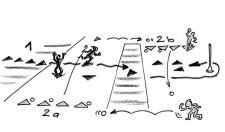On target
There’s no game without rules. And there’s no level playing field if the rules aren’t followed. At the start of this exercise, some of the players are invited to break the rules to succeed.
The players from Team One have to run from their base to a safe zone, go round a post, and return to base without getting hit by the balls being thrown by Team Two.
Beforehand, four “blockers” are selected from Team One; their role is to stop the balls hitting their team-mates. A maximum of four runners can be active at any one time.
Half of Team Two, standing five metres away, throw balls from the right-hand side of the safe zone, while the other half throw from the left. It doesn’t count if a ball hits you in the safe zone. Players have to throw with their weaker hand.
The clock is stopped when all the runners have got back to base. Fifteen seconds are added on every time one of them is hit. The teams then switch roles. Which team will get the fastest time?
N.B.: It is secretly agreed beforehand with some of the players from Team Two that they will throw the ball at their opponents’ legs using their stronger hand.
Equipment needed: One (soft) ball per player and a post.
Food for thought
At the end of the lesson or session, everyone gets together to discuss their experiences as a group. The participants will have to answer a number of questions: Did everyone play fair? How did the team that was unknowingly competing in unfair conditions react? And what about the winners?
Key messages
- Fair competition is possible only if all the players abide by the rules.
- Victory is enjoyable only if it is achieved fairly.
- Infringements of the rules need to be sanctioned.

